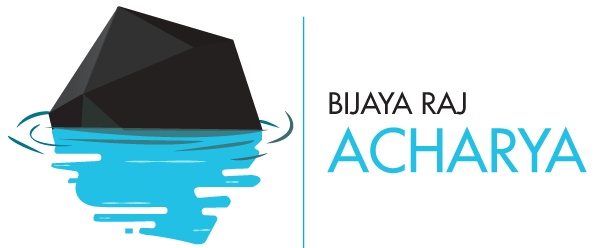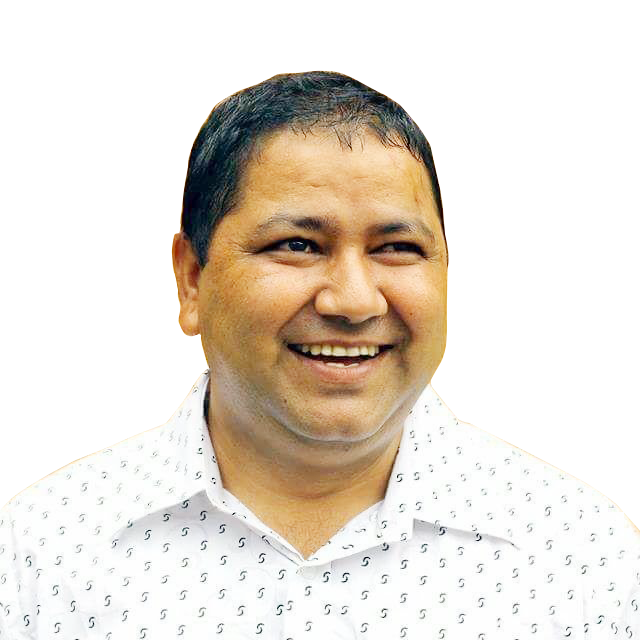FACE TO FACE
WITH BIJAYA RAJ ACHARYA
Mahesh Paudyal
Edition: 2024, First
Layout Design: Saman Shrestha Cover: Ashok Man Singh (Illustration) Krinti Pandey (Photo)
Price: Rs. 50/-
Printed in Nepal
PROFILE OF MR. ACHARYA
BIJAY RAJ ACHARYA is a renowned and well-recognized name in the field of nepali children’s literature. Besides original writing, he also professes, training, publication, editing and translating both children’s and adult’s literature. His works are originally published in nepali, but many of them have also been published in other international languages, including English. Simultaneously writing and managing a publication house, he also is a member of several social, educational and literary organizations, in many of which, his role is that of the leadership. he is also equally honored as editor and tanslator, though his authorial repute surpasses all others. He is more popular, recognized and hailed as an original writer.
Auther Bijaya Raj Acharya was born in a remote location called dangwang, ward no.4 in Pyuthan District on 22 january 1977 to mother Mankala and father Pitambar . He showed literary and creative inclinations right form his boyhood days. He was quite sensitive by nature, and loved to spend his time doing literary creations. The rural images, reflections of rustic life, the pangs of poverty, the thick blanket of superstition, tales of struggle and annals of untouchability and social discrimination found in his writing show how the rural landscape and social life therein have impacted Bijaya’s imaginations. The same village, the same rustic landscape and the same plain and simple life of rusticity propelled Bijaya to move along the path of literary imaginations.
Having completed his high school education in his own village in Pyuthan, Bijaya entered Kathmandu as a dreamer but a strange country lad. His dreams behind moving into the capital were twofold: giving continuity to his education, and identifying the correct path to do justice to his literary inclinations. Before long, he found himself at the pinnacle of both these dreams. He owns a master’s degree in Journalism from Tribhuvan University in one hand, and on the other, he is a writer of great repute. He presently lives in his own home, together with his family, at Taudaha, Kirtipur, Kathmandu.
Bijay did enter the city, but in all these years, the city did not enter his personality. He has kept his simple, natural and guiltless personality intact. His writing is a manifestation of the claim, and his conduct the testimony of his incorrupt soul.
When Bijaya Raj Acharya left Pythan for Kathmandu, he was a dream chaser. Today, within less than two decades, he is counted among the top-seeded children’s writers of Nepal. In children’s literature he
4 – FACE TO FACE WITH BIJAYA RAJ ACHARYA
is among those writers who hold the distinction of publishing the highest number of original books. His writings, laden with rustic images and original experiences, are both entertaining and didactic, aspiring to make children more logical, more scientific and more progressive. His endeavors are relentlessly towards freeing our children from the dogmas of superstition, injustice and atrocities, untouchability and oppression. He is not of the opinion that it suffices for children’s literature to entertain its readers and feed vocabularies. His is a serious socializing project. His writings advocate for better understanding in the family, for better care of aged parents and grandparents, for helping and rescuing peers who are in problem, for love for land and nature, for good care of domestic and wild animals and plants, etc. He also has interest in the changing mindsets and activities of the teenagers, and writes for them as well, directing his pen towards positively inspiring them to guard their changes with care and responsibility. His stories, novels, biographies and picture stories are filled with such positive motivations.
The list of Bijaya’s published works is quite long, and the genres they can be classed into are equally diverse. The number of books he has authored is around eighty, of which more than half have been translated into English. His most renowned books include Kewalpure Kishan, In Search of light, The New Village, The Rising of the Dimstars, Our Voice, Jhamak Kumari, Shanti’s Autobiography, Kanchha Kumar, Shyam Prasad, An
FACE TO FACE WITH BIJAYA RAJ ACHARYA – 5
Encounter with a Leopard, Pioneer Writers, Our Ideals, The Spiny Porcupine, Kokle Kyak Kokle, I Won’t Go to School, Wonderful School, Two Voiceless Girls of Sitlangpur, Budhani, Bijaya Raj Acharya’s Children Stories, Melting Earth etc. Equally many are the works he has edited and translated. The landmark works he has edited include Representative Nepali Plays for Children, Representative Nepali Children’s Stories, World’s Children’s Stories Part I, Nava Pratibha monthly, Hamro Bal Bagaicha monthly etc.
Besides writing, translating and editing, Bijaya is also associated with many literary, social and educational organizations and institutions. He is the former Chairman and Principal of Subhakamana Academy, Kirtipur. He is also the Founder Chairperson of Bibek Sirjanshil Publication, Kathmandu. Besides these two organizations he heads, he is a life member of Ramesh Bikal Literary Foundation, life member of Nepalese Society for Children’s Literature, former central Treasurer of Nepal Progressive Writers’ Association, former Secretary of Mid-Western Regional Literary Council, General Secretary of Children’s Literature and Research Centre, and life member of Pitambar Manakala Memorial Trust. Presently, he is the General Secretary of Nepalese Society for Children’s Literature, NESHIL. He is the life member of Janamat Vangmaya Pratistan, Sahitya Parisad Pyuthan Kathmandu, and Rapti Sahitya Parishad.
For his contributions to literature, Bijaya has won
6 – FACE TO FACE WITH BIJAYA RAJ ACHARYA
several awards and citations which including Best Book Award from Nepalese Society for Children’s Literature 2003, Puskar Gautam Children’s Literature Award 2010, Parijat Best Children’s Literature Manuscript Award 2013 for Babako Maya (Father’s Love), Dilsari-Dal Award from Rapti Literary Council in 2014, and Best Debut Book Award for his first novel Shanti’s Autobiography in 2001. He has also been honored by Janamat Vangmaya Pratistan and Pyuthan Sahitya Parisad.
Divided among these many aspects, Bijaya’s personality fundamentally glitters in his authorial position. In all these dimensions he works for, there is a connecting thread which fundamentally identifies his authorial mission and voice, and that is his faith in progressivity. He never compromises with this ideal, no matter what turn his life takes and where he stands. At the heart of his writing is an urge for positive transformation, and he believes we must train our children’s imaginations in this direction from their tender ages. His language and style are moving, and his heart is both sensitive and dear to children. The child-like heart that always lives inside him has made him an unforgettable celebrity among children today. His children’s literature is worth reading, and is an indispensable brain tonic for our children. The experiences he collects by travelling and feeling the ground realities have enriched his writing with issues close to life, close to the heart, and close to nature. This way, he is fundamentally a writer of reality and naturalness.
FACE TO FACE WITH BIJAYA RAJ ACHARYA – 7
also excels in picture stories for kids. He is among the few Nepali writers who also write for young adults. For adults, he has written Ratki Rani and Pagliyeko Dharati, two collections of haikus and a book, Ke Kasari Lekhne, which is a manual for users intending to teach the nuances of writing various genres.
Another trademark of Mr. Acharya’s writing is his art of adapting older content and re-launching in the language of our kids. Such abridged works borrow from existing body of literature, but in his hands, they assume an altogether different beauty. To name a few, he has published two volumes of Hitopadeshka Kathaharoo and one volume of stories from the Panchatantra for children. The rest of his works are collection of stories and picture stories for kids.
Keyboard, a film has been made based on a story of the same title Mr. Acharya has written. He also has two plays for children to his credits: Harayeki Ma (As I Go Missing) and Tiniharu Kaha Gaya Holan? (Where Could They have Gone?)
Bijaya Raj Acharya also has a few more publications in line, and they include some picture stories, stories, fiction for young adults, memoires and writing manuals.
10 – FACE TO FACE WITH BIJAYA RAJ ACHARYA
Saphaltaka Sutra (Tips for Success), Pari (Fairy), Andhi Keti ra Syal (The Blind Girl and the Fox), Aanti Putali (The Bold Butterfly) and Mama Ghar (The Home of My Mother’s Parents). There are more translations in line due for publication in the near future.
12 – FACE TO FACE WITH BIJAYA RAJ ACHARYA
theoretical book), Chhauko Ghau (The Wounds of Menstruation, picture story), Phurse (novel for kids), Vishwa Prasiddha Lok Katha (World Famous Folktales, part 5), Jaduko Chhadi (The Magical Wand, famous Chinese novel for kids), Ramaila Chiniya Bal Katha (Interesting Chinese Stories for Children, part 3 in translation), Harayeki Ma (My Lost Self, a collection of stories for young adults), Ajambari Phoolharu (Immortal Flowers, biographies), Taudahadekhi Blackpoolsamma (From Taudaha to Black Pool, travel memoir), Siddhartha (play for kids), Hiloma Phuleko Phool (Lotus in the Mud, picture story based on the life of famous artist KK Karmacharya), Creative Writing, and Pushpakamal, a collection of haikus, Tiniharu Kahan Gaye Holan (Where Could they have Gone, picture story), Saras Ra Manish (The Crane and the Man, picture story), Jenishko Janmadin (The Birthday of Jenish, picture story), Keyboard (picture story) Khada Devi (picture story), Sanyasi Raja (The Recluse King, picture story), Chhauko Ghau (The Pain of Menstruation, picture story), Swargako Mobile (The Mobile in Heaven, picture story), Paap Pakhalne Ganga (The Holy Ganga, picture story), Bubako Maya (Fathers’ Love, picture story) and Pushpakamal (A Collection of Haiku).

